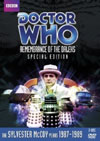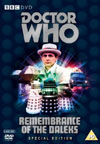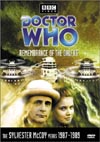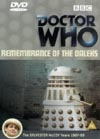Special Edition DVD Extras include:
Group-Captain "Chunky" Gilmore is an obvious substitution for Brigadier Lethbridge-Stewart, both looking the part and fulfilling essentially the same functions in the script.... and a slip of the tongue from the Doctor at one point makes the comparison obvious. Sgt. Mike Smith copies Captain Mike Yates in more ways than I will go into here - even the name didn't change much with this one. Rachel is a faithful clone of Liz Shaw from season seven, with nearly identical motivations throughout. And although Allison manages a somewhat different look and portrayal once the actress inhabits the part, it wouldn't be too hard to interpret her as Jo Grant, particularly as her main function appears to be pulling audience-perspective answers out of Rachel and the Doctor. With these tried-and-true character dynamics, and the host of good actors assembled here to pull it off, success isn't hard to achieve. Amongst this cast of characters that are new in name only, the Doctor is once more at home. Of course, adding Ace on top of this is yet another bonus, as she adds new dynamics to interact with familiar ones and produce scenes and humour that we haven't really had before in the UNIT days. Both the writers and actress Sophie Aldred build on what had begun in her debut in "Dragonfire" (story no. 151) and define Ace's continuing role to be a surprisingly active, feisty, and humorously likeable character who works well with the Doctor and the new people he regularly encounters.
Opening NightStrangely, both "Time and the Rani" (story no. 148) and this story turn out to be the only Sylvester McCoy stories that fail to feature an opening materialization for the Doctor's vehicle. The TARDIS interior set is also about to make itself VERY scarce from here on. Despite the considerable mileage that the story wants to get out of both the Doctor's alien background and Ace's relatively futuristic background, it is bizarre that they are denied the staple, simple, fun setup that a suitable entrance with the TARDIS would normally give them. Thus another of Doctor Who's "good" shows once more proves unnecessarily less than ideal for initiating new viewers to the program.The numerous re-caps of Dalek/Doctor history from early eras shows that Aaronovitch has successfully researched his stuff, but one senses that the writer's creative freedom is starting to get cramped by revisiting too many old settings instead of new ones. Although things are still largely okay here, the trend begun here will later cause many more problems. Sylvester McCoy's Doctor suddenly seems much more serious and compelling here than before, even though his humour still abounds. What gags are attempted this time around are done single-camera on location, which produces a MUCH better result than the in-studio run-on long-shots that appeared so staged back in "Time and the Rani". Part One continues to be the true tour-de-force of tradition, as it gets into a classic formula from the Pertwee years. Strangely though, the combination of forces we have here never did occur in the Pertwee years as successfully and iconically as what we get here, helping to keep this encounter fresh. The succession of story beats here very nicely build upon each other, and work well to emphasize important characteristics of the Doctor, some of which we're seeing for the first time in McCoy's version. Episode One's good stuff all leads up to an actual cliffhanger that gives us something new from the Daleks - something often talked about but never before seen in any TV episode or film. Brilliant. This has been a VERY good first episode for the season, no doubt garnering more viewers for the story and the season as word of mouth spread.
Mythological ConvolutionsRacism turns out to be the biggest underlying thematic point in the story, but although a good number of scenes dabble in it, it never really rises to the level of importance that it deserves. Many opportunities to highlight, dig into, and work with the issue remain under-developed, until it becomes just a bit of motivational detail rather than something integral to the story. Too bad such a good opportunity was casually thrown away.... but once again for the McCoy era, the novelization was able to make a bit more out of this than what appeared on screen.Although the main plot of the story is solidly worked out and presented on screen, many of the smaller details appear to have been rewritten too often, until a few gaping holes appear. Of course, I'll save such details and spoilers for the in-depth analysis version of this review, where those who have seen the story already can read more. One thing I will bring up even here is that it seems very unlikely that the Doctor was actually plotting anything too specific to this story back in "An Unearthly Child" (story no. 1), since he is clearly discovering the entire nature and existence of the Dalek race in "The Daleks" (story no. 2) - a point easily lost as professional fandom continues to elevate Dalek vs. Time Lord mythology to such heights that you wonder how the Doctor wouldn't have learned all about them in school. And really, the modern, heavily mythological stories usually lack dynamics that are better than the initial, explorative, first-contact encounters with the creatures in their first story. It really is better to honour the events of "An Unearthly Child" and "The Daleks" as they were, without adding overcomplicated mythology.
"I can do anything I like!"This line, uttered while angrily yanking his umbrella out of a Dalek hatch, reminded me so much of David Tennant's Doctor uttering an almost identical line from the end of "Voyage of the Damned" (story no. 193). I think we can see here in "Remembrance" how a lot of the character's worst long-term ego problems set in, as he assumes his new mantle of the master manipulator. Mind you, it does keep him dramatically interesting, which is a noble goal. But rooting for him philosophically has become perhaps a bit more complicated than it really should be.The final moments of the conflict in the main "A"-plot are generally well done, while some of the other bits... not so much. Part Four seems a bit more distracted than necessary, even though it is still superbly entertaining and generally quite satisfying.
ProductionOf course, we can't leave off without mentioning the superb improvements in video effects for this story, especially those masterminded by the program's long-serving video wizard Dave Chapman. Very bluntly, this story calls for a LOT of effects, and really none of them are skimped on. Laser effects are abundant everywhere you'd want them and then some, becoming one of the key ingredients that keep the story's prolific battles exciting. The story is a bit unique in the style of laser effects used, since future Dalek stories reverted to more traditional ideas, making "Remembrance" a bit more special in that regard. Transmat is another staple required effect that has not always been done justice on Doctor Who, but here we get the effect we need and want, with three layers of visual interest instead of just one, plus timing and subtleties that add really nicely and appropriately to the creep factor in a number of scenes. Model shots are also working well, overcoming the problem seen in other stories of this era that lack stars behind anything that moves, but there is at least one specific drawback to the story's effects.... and I think I don't want to spoil that here either, since it doesn't really hurt the story, which is so captivating that new viewers may not really notice such flaws on their own until their 3rd or 4th viewing. In addition, Chapman and company pull off some VERY good work conquering this same problem in other shots, proving once more that they were on the cusp of the next revolution of television effects at the time in 1988.
What? This one's not in your DVD collection already? Get it right now, without delay!
This story has become available on DVD and VHS video.
Comments on this article are welcome. You may contact the author from this page:
|
|||||||||||||||||||||||||||||||||||||||||||||||











